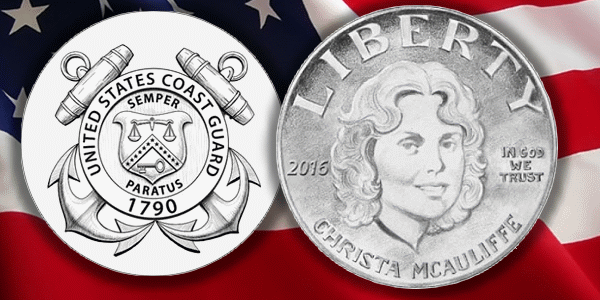
House version of COINS Act also introduced
By CoinWeek News Staff ….
Four coin-related bills were introduced into Congress in the last few weeks, three of which would authorize the United States Mint to strike new commemorative coins for the year 2020.
The first to be introduced was H.R. 2256–the Christa McAuliffe Commemorative Coin Act of 2017. Representative Fred Upton (R-MI6) presented the bill to the House on April 28; it currently awaits review by the Financial Services Committee headed by Representative Jeb Hensarling (R-TX3). Upton proposed similar legislation previously in 2016 but it failed to gain traction in committee.
At the time of this writing, the bill has three cosponsors: Suzanne Bonamici (D-OR1), Debbie Dingell (D-MI12) and Randy Hultgren (R-IL14)
Five days later, the United States Coast Guard Commemorative Coin Act of 2017 (H.R. 2317) was introduced on May 3 by Representative Joe Courtney (D-CT2) along with 56 cosponsors (46 democrats and 10 republicans). It, too, sits with the House Financial Services Committee. Christopher Murphy (D), the junior senator from Connecticut, introduced the Senate version (S. 1021) on the same day. Senior Senator Richard Blumenthal (D-CT) and Sen. John Boozman (R-AR) served as cosponsors. The bill has been referred to the Senate Banking, Housing, and Urban Affairs Committee.
Courtney introduced earlier versions of the Coast Guard Commemorative Coin Act in 2013 and 2015; Murphy did the same in the Senate in 2014 and 2015.
Designs & Specifications
The Christa McAuliffe Commemorative Coin Program honors the life and legacy of Sharon Christa McAuliffe. McAuliffe was a social studies teacher from Concord, New Hampshire selected in 1985 by the National Aeronautics and Space Administration (NASA) under its “Teacher in Space” program to be the first American civilian in space. She was one of seven crew members on the Space Shuttle Challenger when it exploded 73 seconds after launch on January 28, 1986, killing everyone on board. Almost immediately, schools and scholarships were named in her honor, and programs like FIRST (For Inspiration and Recognition Of Science & Technology; founded in 1989) were started to carry on her work promoting science education. McAuliffe was given a posthumous Congressional Space Medal of Honor by President George W. Bush in 2004.
Upton’s bill authorizes the Mint to strike a maximum of 350,000 one-dollar silver coins in both Proof and Uncirculated finishes. The coins would weigh 26.73 grams, be 1.5 inches in diameter, and consist of at least 90% pure silver. Per usual, the Not-Intended-For Circulation (NIFC) commemorative would be legal tender in the United States and would be classified as a numismatic object for tax purposes.
The obverse would be required to feature an image of Christa McAuliffe, while the reverse would focus on her legacy as a teacher. The standard inscriptions (LIBERTY, IN GOD WE TRUST, UNITED STATES OF AMERICA, the year 2020, etc.) would be present on the appropriate side of the coin as mandated by law. The Citizens Coinage Advisory Committee (CCAC) would review candidate designs and the Secretary of the Treasury would select the final design after consultation with FIRST, the McAuliffe Family, and the Commission of Fine Arts (CFA).
The United States Coast Guard Commemorative Coin Program would be a three-coin set consisting of a $5 gold coin, a $1 silver coin and a clad half dollar. All would be available in Uncirculated and Proof versions, with at least two mint facilities to be used – one for Proofs, and at least one for Uncirculated pieces. Courtney and Murphy’s bills set maximum mintages of 100,000 gold coins, 500,000 silver dollars and 750,000 half dollars. The gold coin would weigh 8.359 grams, have a diameter of 0.850 inches, and be composed of 90% gold and 10% alloy. Specifications for the silver coin are the same as for the Christa McAuliffe commemorative dollar. The clad half dollar would weigh 11.34 grams and be 1.205 inches across.
Again, the NIFC collector coins would be legal tender and classed as numismatic objects under United States Code.
The design of the Coast Guard commemoratives must be “emblematic of the traditions, history, and heritage of the United States Coast Guard, and its role in securing our nation since 1790”. The law specifies that past and present representations of Coast Guard service members must be incorporated into the motif, and concern both the wartime and peacetime functions of the Guard. The CCAC would review designs and the Treasury Secretary would make the final selections after consulting with the Secretary of Homeland Security, the National Coast Guard Museum Association, and the CFA.
The United States Coast Guard is the oldest seafaring branch of the military, with roots going back to 1790. It became part of the Department of Homeland Security in 2003. Its motto is Semper Paratus (“Always Ready”).
Interestingly, the Coast Guard is the only U.S. military service without a museum. The creation of a national museum was authorized in 2004 by Public Law 108-293; this commemorative coin program is meant to be one avenue of funding for that project.
Surcharges
Speaking of surcharges, the Christa McAuliffe commemorative $1 silver coin will have a retail premium of $10 over face value. This is designated to go to the FIRST robotics program.
Surcharges of $35 for the five-dollar gold, $10 for the one-dollar silver, and $5 for the clad half dollar coin will go to the National Coast Guard Museum Association.
COINS Act of 2017, Revisited
IN ADDITION to the commemorative programs above, another piece of coinage-related legislation was introduced to the House of Representatives on May 2. H.R. 2299, sponsored by Representative Claudia Tenney (R-NY22), Robert Brady (D-PA1) and Walter Jones (R-NC3). It is the House version of the Currency Optimization, Innovation, and National Savings (COINS) Act of 2017 (S. 759) sponsored by Senators John McCain (R-AZ) and Mike Enzi (R-WY).
The primary difference between the two bills is that the House bill requires the Comptroller General of the United States to conduct a study on the cost of production of the one-cent coin and make recommendations on ways to lower said costs. This report would be due before the relevant committees in both the House and Senate within 180 days of the enactment of H.R. 2299.
Live update widgets for all of the above proposals are found below.
* * *
Sources
https://www.govtrack.us/congress/bills/115/hr2256
https://www.govtrack.us/congress/bills/114/hr5168
https://www.govtrack.us/congress/bills/115/hr2317
https://www.govtrack.us/congress/bills/115/s1021





Too bad that the sponsors feel that McAuliffe is more deserving than the others on her flight. I would not support that one for that reason.
The Coast Guard does not need a three coin program. One would be sufficient.